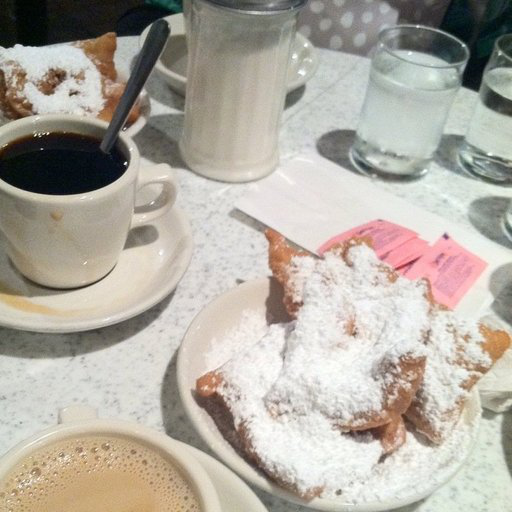Transformers documentation
이미지 분류
이미지 분류
이미지 분류는 이미지에 레이블 또는 클래스를 할당합니다. 텍스트 또는 오디오 분류와 달리 입력은 이미지를 구성하는 픽셀 값입니다. 이미지 분류에는 자연재해 후 피해 감지, 농작물 건강 모니터링, 의료 이미지에서 질병의 징후 검사 지원 등 다양한 응용 사례가 있습니다.
이 가이드에서는 다음을 설명합니다:
이 작업과 호환되는 모든 아키텍처와 체크포인트를 보려면 작업 페이지를 확인하는 것이 좋습니다.
시작하기 전에, 필요한 모든 라이브러리가 설치되어 있는지 확인하세요:
pip install transformers datasets evaluate
Hugging Face 계정에 로그인하여 모델을 업로드하고 커뮤니티에 공유하는 것을 권장합니다. 메시지가 표시되면, 토큰을 입력하여 로그인하세요:
>>> from huggingface_hub import notebook_login
>>> notebook_login()Food-101 데이터 세트 가져오기
🤗 Datasets 라이브러리에서 Food-101 데이터 세트의 더 작은 부분 집합을 가져오는 것으로 시작합니다. 이렇게 하면 전체 데이터 세트에 대한 훈련에 많은 시간을 할애하기 전에 실험을 통해 모든 것이 제대로 작동하는지 확인할 수 있습니다.
>>> from datasets import load_dataset
>>> food = load_dataset("ethz/food101", split="train[:5000]")데이터 세트의 train을 train_test_split 메소드를 사용하여 훈련 및 테스트 세트로 분할하세요:
>>> food = food.train_test_split(test_size=0.2)그리고 예시를 살펴보세요:
>>> food["train"][0]
{'image': <PIL.JpegImagePlugin.JpegImageFile image mode=RGB size=512x512 at 0x7F52AFC8AC50>,
'label': 79}데이터 세트의 각 예제에는 두 개의 필드가 있습니다:
image: 식품 항목의 PIL 이미지label: 식품 항목의 레이블 클래스
모델이 레이블 ID에서 레이블 이름을 쉽게 가져올 수 있도록 레이블 이름을 정수로 매핑하고, 정수를 레이블 이름으로 매핑하는 사전을 만드세요:
>>> labels = food["train"].features["label"].names
>>> label2id, id2label = dict(), dict()
>>> for i, label in enumerate(labels):
... label2id[label] = str(i)
... id2label[str(i)] = label이제 레이블 ID를 레이블 이름으로 변환할 수 있습니다:
>>> id2label[str(79)]
'prime_rib'전처리
다음 단계는 이미지를 텐서로 처리하기 위해 ViT 이미지 프로세서를 가져오는 것입니다:
>>> from transformers import AutoImageProcessor
>>> checkpoint = "google/vit-base-patch16-224-in21k"
>>> image_processor = AutoImageProcessor.from_pretrained(checkpoint)이미지에 몇 가지 이미지 변환을 적용하여 과적합에 대해 모델을 더 견고하게 만듭니다. 여기서 Torchvision의 transforms 모듈을 사용하지만, 원하는 이미지 라이브러리를 사용할 수도 있습니다.
이미지의 임의 부분을 크롭하고 크기를 조정한 다음, 이미지 평균과 표준 편차로 정규화하세요:
>>> from torchvision.transforms import RandomResizedCrop, Compose, Normalize, ToTensor
>>> normalize = Normalize(mean=image_processor.image_mean, std=image_processor.image_std)
>>> size = (
... image_processor.size["shortest_edge"]
... if "shortest_edge" in image_processor.size
... else (image_processor.size["height"], image_processor.size["width"])
... )
>>> _transforms = Compose([RandomResizedCrop(size), ToTensor(), normalize])그런 다음 전처리 함수를 만들어 변환을 적용하고 이미지의 pixel_values(모델에 대한 입력)를 반환하세요:
>>> def transforms(examples):
... examples["pixel_values"] = [_transforms(img.convert("RGB")) for img in examples["image"]]
... del examples["image"]
... return examples전체 데이터 세트에 전처리 기능을 적용하려면 🤗 Datasets with_transform을 사용합니다. 데이터 세트의 요소를 가져올 때 변환이 즉시 적용됩니다:
>>> food = food.with_transform(transforms)이제 DefaultDataCollator를 사용하여 예제 배치를 만듭니다. 🤗 Transformers의 다른 데이터 콜레이터와 달리, DefaultDataCollator는 패딩과 같은 추가적인 전처리를 적용하지 않습니다.
>>> from transformers import DefaultDataCollator
>>> data_collator = DefaultDataCollator()평가
훈련 중에 평가 지표를 포함하면 모델의 성능을 평가하는 데 도움이 되는 경우가 많습니다. 🤗 Evaluate 라이브러리로 평가 방법을 빠르게 가져올 수 있습니다. 이 작업에서는 accuracy 평가 지표를 가져옵니다. (🤗 Evaluate 빠른 둘러보기를 참조하여 평가 지표를 가져오고 계산하는 방법에 대해 자세히 알아보세요):
>>> import evaluate
>>> accuracy = evaluate.load("accuracy")그런 다음 예측과 레이블을 compute에 전달하여 정확도를 계산하는 함수를 만듭니다:
>>> import numpy as np
>>> def compute_metrics(eval_pred):
... predictions, labels = eval_pred
... predictions = np.argmax(predictions, axis=1)
... return accuracy.compute(predictions=predictions, references=labels)이제 compute_metrics 함수를 사용할 준비가 되었으며, 훈련을 설정하면 이 함수로 되돌아올 것입니다.
훈련
Trainer를 사용하여 모델을 미세 조정하는 방법에 익숙하지 않은 경우, 여기에서 기본 튜토리얼을 확인하세요!
이제 모델을 훈련시킬 준비가 되었습니다! AutoModelForImageClassification로 ViT를 가져옵니다. 예상되는 레이블 수, 레이블 매핑 및 레이블 수를 지정하세요:
>>> from transformers import AutoModelForImageClassification, TrainingArguments, Trainer
>>> model = AutoModelForImageClassification.from_pretrained(
... checkpoint,
... num_labels=len(labels),
... id2label=id2label,
... label2id=label2id,
... )이제 세 단계만 거치면 끝입니다:
- TrainingArguments에서 훈련 하이퍼파라미터를 정의하세요.
image열이 삭제되기 때문에 미사용 열을 제거하지 않는 것이 중요합니다.image열이 없으면pixel_values을 생성할 수 없습니다. 이 동작을 방지하려면remove_unused_columns=False로 설정하세요! 다른 유일한 필수 매개변수는 모델 저장 위치를 지정하는output_dir입니다.push_to_hub=True로 설정하면 이 모델을 허브에 푸시합니다(모델을 업로드하려면 Hugging Face에 로그인해야 합니다). 각 에폭이 끝날 때마다, Trainer가 정확도를 평가하고 훈련 체크포인트를 저장합니다. - Trainer에 모델, 데이터 세트, 토크나이저, 데이터 콜레이터 및
compute_metrics함수와 함께 훈련 인수를 전달하세요. - train()을 호출하여 모델을 미세 조정하세요.
>>> training_args = TrainingArguments(
... output_dir="my_awesome_food_model",
... remove_unused_columns=False,
... eval_strategy="epoch",
... save_strategy="epoch",
... learning_rate=5e-5,
... per_device_train_batch_size=16,
... gradient_accumulation_steps=4,
... per_device_eval_batch_size=16,
... num_train_epochs=3,
... warmup_steps=0.1,
... logging_steps=10,
... load_best_model_at_end=True,
... metric_for_best_model="accuracy",
... push_to_hub=True,
... )
>>> trainer = Trainer(
... model=model,
... args=training_args,
... data_collator=data_collator,
... train_dataset=food["train"],
... eval_dataset=food["test"],
... processing_class=image_processor,
... compute_metrics=compute_metrics,
... )
>>> trainer.train()훈련이 완료되면, 모든 사람이 모델을 사용할 수 있도록 push_to_hub() 메소드로 모델을 허브에 공유하세요:
>>> trainer.push_to_hub()이미지 분류를 위한 모델을 미세 조정하는 자세한 예제는 다음 PyTorch notebook을 참조하세요.
추론
좋아요, 이제 모델을 미세 조정했으니 추론에 사용할 수 있습니다!
추론을 수행하고자 하는 이미지를 가져와봅시다:
>>> ds = load_dataset("ethz/food101", split="validation[:10]")
>>> image = ds["image"][0]
미세 조정 모델로 추론을 시도하는 가장 간단한 방법은 pipeline()을 사용하는 것입니다. 모델로 이미지 분류를 위한 pipeline을 인스턴스화하고 이미지를 전달합니다:
>>> from transformers import pipeline
>>> classifier = pipeline("image-classification", model="my_awesome_food_model")
>>> classifier(image)
[{'score': 0.31856709718704224, 'label': 'beignets'},
{'score': 0.015232225880026817, 'label': 'bruschetta'},
{'score': 0.01519392803311348, 'label': 'chicken_wings'},
{'score': 0.013022331520915031, 'label': 'pork_chop'},
{'score': 0.012728818692266941, 'label': 'prime_rib'}]원한다면, pipeline의 결과를 수동으로 복제할 수도 있습니다:
이미지를 전처리하기 위해 이미지 프로세서를 가져오고 input을 PyTorch 텐서로 반환합니다:
>>> from transformers import AutoImageProcessor
>>> import torch
>>> image_processor = AutoImageProcessor.from_pretrained("my_awesome_food_model")
>>> inputs = image_processor(image, return_tensors="pt")입력을 모델에 전달하고 logits을 반환합니다:
>>> from transformers import AutoModelForImageClassification
>>> model = AutoModelForImageClassification.from_pretrained("my_awesome_food_model")
>>> with torch.no_grad():
... logits = model(**inputs).logits확률이 가장 높은 예측 레이블을 가져오고, 모델의 id2label 매핑을 사용하여 레이블로 변환합니다:
>>> predicted_label = logits.argmax(-1).item()
>>> model.config.id2label[predicted_label]
'beignets'